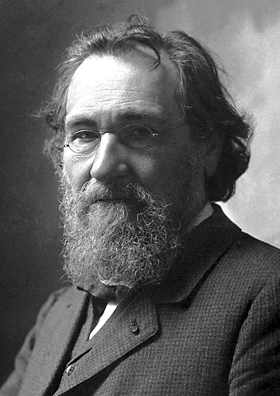by Piter Kehoma Boll
For the third week in a row, our featured scientist is a Nobel laureate!
Ilya Ilyich Mechnikov (in Russian: Илья Ильич Мечников), also known as Élie Metchnikoff, was born on 15 May 1845 in the village of Ivanovka in Ukraine. His father, Ilya Ivanovich Mechnikov was a Russian officer of the Imperial Guard and his mother, Emilia Lvovna Nevakhovich was the daughter of the writer Leo Nevakhovich.

In 1856, at the age of 11, Metchnikoff entered the Kharkiv Lycée school and developed an interest in biology. Due to his mother’s influence, he was interested in science since and early age. She also convinced him to study natural sciences instead of medicine. Thus, in 1862, he tried study biology at the University of Würzburg, in Germany but, as the academic year there would only begin by the end of the year, he ended up enrolled at the Kharkiv University to study natural sciences. In 1863, he married Ludmila Feodorovitch and, in 1864, graduated at the age of 19, completing the four-year degree of natural sciences in only two. That same year, he went to Germany to study the marine fauna on the island of Heligoland in the North Sea.
After meeting the botanist Ferdinand Cohn, Metchnikoff was advised by him to work with the zoologist Rudolf Leuckart at the University of Giessen. Together with Leuckart, he studied the reproduction of nematodes and discovered intracellular digestion in flatworms. In 1866, he moved to Naples and worked on a doctoral thesis on the embryonic development of cuttlefish of the genus Sepiola. In 1867, he moved to Russia and received his doctorate degree with Alexander Kovalevsky from the University of St. Petersburg. For their work on the development of germ layers of invertebrate embryos, Metchnikoff and Kovalevsky won the Karl Ernst von Baer prize.
Due to his competence, Metchnikoff was appointed, still in 1867, professor of the new Imperial Novorossiya University (currently Odessa University). He was only 22 years old, being younger than most of his students. The next year, due to a conflict with a senior colleague, he was transferred to the University of St. Petersburg but the professional environment there was even worse. He returned to Odessa in 1870 as professor of Zoology and Comparative Anatomy.
On April 20, 1873, Metchnikoff’s wife died of tuberculosis. This event, combined with his professional problems, made him attempt suicide taking a large dose of opium. He survived and eventually recovered and, in 1875, married his student Olga Belokopytova.
The assassination of Alexander II in 1881 led to political turmoils in Russia, which made Metchnikoff resign from Odessa University in 1882. He moved to Sicily and set up a private laboratory in Messina. There, while studying starfish larvae, he noticed that, by inserting a small citrus thorn in the larvae, a group of cells started to surround the thorn. He suggested that some white cells in the blood are able to attack and kill pathogens, and the zoologist Carl Friedrich Wilhelm Claus, with whom he discussed his hypothesis, suggested the name “phagocyte” to such cells.

Metchnikoff presented his findings on phagocytes at Odessa in 1883, but his idea was met with skepticism from many specialists, including Louis Pasteur. The idea at that time was that white blood cells carried pathogens away from the infection place and delivered them elsewhere, spreading them instead of destroying them. His main supporter was the pathologist Rudolf Virchow. Back to Odessa, Metchnikoff was appointed director of an institute created to produce Louis Pasteur’s vaccine against rabies.
In 1885, Metchnikoff’s second wife suffered from severe typhoid fever. As a result, he attempted suicide once more, this time by injecting himself with spirochaete bacteria that cause relapsing fever. He survived again, and his wife survived as well.
In 1888, Metchnikoff left Odessa again due to new difficulties and went to Paris to seek the advice of Pasteur, who gave him an appointment at the Pasteur Institute. Metchnikoff remained there for the rest of his life. In 1908, he won the Nobel prize in physiology or medicine due to his discovery of phagocytes. During his last years, he developed a theory that aging was a disease caused by toxic bacteria in the gut and that lactic acid produced by Lactobacillus could prolong life.
He died on 15 July 1916 of heart failure in Paris, aged 71.
– – –
– – –
Reference:
Goldstein BI (1916) Elie Metchnikoff. The Canadian Jewish Chronicle. Available at < https://news.google.com/newspapers?id=BQodAAAAIBAJ&sjid=xGEEAAAAIBAJ&pg=6460,5413902&dq=%C3%A9lie+metchnikoff&hl=en >. Access on 14 May, 2019.
Wikipedia. Élie Metchnikoff. Available at <
https://en.wikipedia.org/wiki/%C3%89lie_Metchnikoff >. Access on May 14, 2019.
